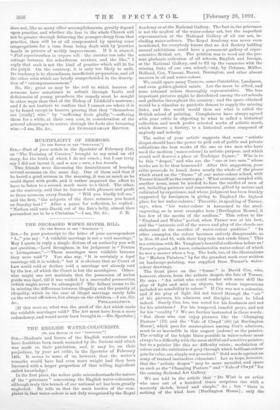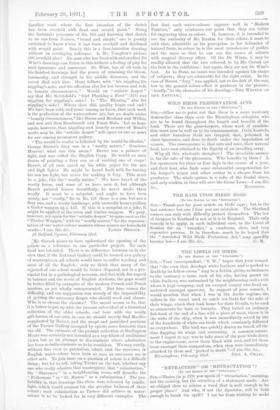THE ENGLISH WATER-COLOURISTS.
[TO TRU EDITOR OF THE " SPROTATOR.1 SIR,—Students and lovers of the English water-colour art have doubtless been much wounded by the furious raid which was made on their patriotism, and, it may be, on their prejudices, by your art critic, in the Spectator of February 14th. It seems to some of us, however, that the writer's remarks would have had even more weight had they been leavened with a larger proportion of that telling ingredient called knowledge!
In the first place, the writer quite misunderstands the nature of the " grievance " concerning the English water-colourists, although truly this branch of our national art has been greatly. neglected. He tells us that the main burden of the corn- plaint is, that water-colour is not duly recognised by the Royal nothing of the kind here [Burlington House] ; only the
Academy or at the National Gallery. The fact is, the grievance, is not the neglect of the water-colour art, but the imperfect representation at the National Gallery of all our art, in- eluding water-colours. The Royal Academy was never even mentioned, for everybody knows that no Art Society holding' annual exhibitions could have a permanent gallery of repre-- sentative British art. The petition was to weed out the pre- sent plethoric collection of all schools, English and foreign, at the National Gallery, and to fill up the vacancies with the missing links of our own school,—say, by Cotman,
Holland, Cox, 'Vincent, Barret, Bonington, and other absent masters in oil and water-colour.
We could spare many Turners, some Constables, Landseers, and even golden-gloried saints. Let the mass be sifted, and' none retained unless thoroughly representative. The less. important pictures might be distributed among the art schools and galleries throughout the country ; and the space obtained would be a stimulus to patriotic donors to supply the missing links, and the world would then see what is called the British school of painting. Complainers have always agreed with your critic in objecting to what is called a historical collection, and much prefer selected works of artistic merit, which deserve a history, to a historical series composed of anybody and nobody.
The writer of your article suggests that some " artistic- despot should have the power to pick out of public and private, collections the best works of the one or two men who have' used the medium [water-colour] to artistic purpose, and which would well deserve a place at Trafalgar Square." Who is to be this "despot," and who are the "one or two men" whose works are to be thus honoured P After this suggestion, your- critic proceeds to knock down nearly the whole of the pieces which stand on the " frame " of our water-colour school, with Turner himself as the centre-pin ! What courage, coupled with another noun, must be needed to face the verdict of men of art, including painters and connoisseurs, gifted by nature and cultivated by experience, and whose judgment has been frankly supported by foreigners in giving to England the highest place for her water-colours ! The critic, in speaking of Turner,. says, when "his water-colour is harnessed to the steel- engraving, as in most examples here [Burlington House], it has few of the merits of the medium." This refers to the "England and Wales" period, when Turner was at his best, and the "intricate coil of the waves and play of the clouds are elaborated at the sacrifice of water-colour qualities." "In other examples, the colour becomes entirely disagreeable, as, in Nos. 89 and 91, with their foxy reds and crude blues." This is a criticism with Mr. Vaughan's beautiful collection before us r Turner's genius, all know, culminated in water-colour, of which he was a master when a boy. The bulk, too, of the illustrations' for "Modern Painters," by far the grandest work ever written on landscape-painting, was supplied from Turner's water- colour drawings. The front piece on the "frame " is David Cox, who, however, shares, from the artistic despot, the fate of Turner.. He says : "An artist who could render with some skill the play of light and mist on objects, but whose impressions included no sensibility to colour." If Cox was not a colourist, and if his play of light did not travel through the " air " of his pictures, his admirers and disciples must be blind indeed. Surely Cox, too, was noted for his freshness and not for his mistiness P For his tempered, tuneful greys, and not for his "crudity "P We are further instructed in these words : "But those who can enjoy pictures like the Changing' Pasture' (73) and the Vale of Clwyd' (80) [at Burlington House], which pass for masterpieces among Cox's admirers, must be as insensible in this respect [colour] as the painter. The crudity of the bright blues possible in water-colour must always be a difficulty with the most skilful and sensitive painter; but to a painter like this no difficulty exists ; modulation of colour and the subtleties of grey through which brilliant colour gets its value, are simply not perceived." Bold words against an army of trained instinctive colourists! Let us hope, however, that the "artistic despot" may be more merciful, and spare, us such as the" Changing Pasture" and "Vale of Clwyd" for the coming National Art Gallery.
We are told in the article that "Do Wint is an artist who once out of a, hundred times surprises one with a masterly sketch, broad and simple," &c. ; but "there is familiar work where the first intention of the sketch has been overlaid with dead and stupid paint." Being the fortunate possessor of No. 102, and knowing that sketch to be one from Nature, "broad and simple," one is greatly exercised to know where it has been overlaid, and deadened with stupid paint. Surely this is a first-intention drawing without an overlaying influence. Is Mr. Vaughan's picture (99) overlaid also ? No man who has lived with and studied De Whit's drawings can listen to this without a feeling of pity for such ignorance and assurance. De Wint, too, of all men, in his finished drawings had the power of retaining the bloom, luminosity, and strength in his middle distances, and the secret died with him. Hunt follows with "his niggling for niggling's sake, and his affection also for hot browns and reds in homely circumstances." Would an "artistic despot" say that Mr. Nettlefold's ." Girl Plucking a Fowl" (115) was niggling for niggling's sake P Is "The Blessing" also for niggling's sake ? Where does this quality begin and end ? We have been told, and some among us know, that such work is the perfection of the water-colour art, but no doubt under "homely circumstances," like Burns and Morland and Wilkie, and now and then Rembrandt and Franz Haifa Let us hope again, however, that, niggling and homely as some of Hunt's works may be, the "artistic despot" will spare us one or more for our coming permanent gallery.
"The would-be realist is followed by the would-be idealist," George Barret's foxy sun in a "woolly nature." Gracious Heaven ! what can this mean ? Barret was a painter of light, and was called the English Cuyp. He would as soon dream of painting a foxy sun as of making one of crape ! Barret, of all men, saved up his white paper for his sun and high lights. He might be found fault with for leaving his sun too light, but never for making it foxy. This must be a joke, like the "woolly nature." We have *heard of the woolly horse, and some of us have seen it, but although Barret painted horses beautifully, he never made them woolly. It must be a misprint, and ought to have been woody, not "woolly," for in No. 121 there is a sun, but not a foxy one, and a woody landscape, with unwoolly horses pulling a timber waggon up a hill. If this is a misprint or a joke, it might be applied to the trees and timber waggon. We pray, however, yet again for the "artistic despot" to spare such as the "Timber Waggon," with its "woolly nature," for the represen- tation of our water-colour masters whose names are household [Mr. Orroek seems to have understood the opening of the article as a reference to one particular project. No such limit was intended. There is no difference between us in the view that, if the National Gallery could be treated as a gallery of masterpieces, all schools would have to suffer weeding, and most of all the English ; only we think that many of the rejected of our school would be better disposed, not in a pro- vincial but in a pathological museum, and that with due regard to balance and the needs of English students, the gaps would be better filled by examples of the modern French and Dutch masters, as yet wholly unrepresented. But here comes the difficulty, and our suggestion was merely of the impossibility of getting the necessary despot who should weed and choose. Who is to choose the chooser? The moral seems to be, that A is better to put up with the present sober ideal of a historical collection of the older schools, and bear with the weedy gift-horses of our own, in case we should merely find Maclise supplanted by Barret, and the swept and garnished portions of the Turner Gallery occupied by spirits more fantastic than the old. The estimate of the present collection at Burlington House was certainly not intended as a repetition of traditional views, but as an attempt to discriminate where admiration has been so indiscriminate as to be worthless. We may surely, without loss even to patriotism, admit that the successes in English water-colour have been as rare as successes are in other arts. To join issue on a question of colour is a difficult thing ; but let us ask, taking Turner as the test, whether any one who really admires that masterpiece, that "culmination," the " Sheerness " in a neighbouring room, will describe the " Folkestone " or "St. Mawes " as a culmination ? The pro- bability is, that drawings like these were coloured by candle- light, which would account for the peculiar badness of their colour ; such culmination as Turner did achieve in water- colour is to be looked for in very different examples. The fact that such water-colours engrave well in "Modern Painters," only reinforces our point that they are better for engraving than as colour. If, however, it is intended to use the authority of Mr. Ruskin for their colour, it must be said that, admirable as his perception is for delicacies of natural form, in colour he is the most treacherous of guides, and the more so that he can use the names of colours with magical literary effect. Of the De Wints, it may be readily allowed that the two referred to by Mr. Orrock are the best in the exhibition ; but again, they are not De Wint's best. As to Hunt, no taunt was intended against his choice of subjects ; they are admirable for the right artist. In the case of Barret, " foxy " was applied, not to the disk of the sun, but to the general colour-effect it produces in the picture ; "woolly," to the character of his drawing.—THE WRITER OF THE ARTICLE.]







































 Previous page
Previous page